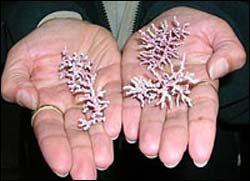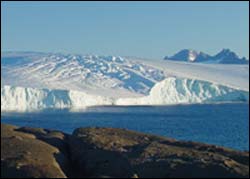
While researchers in Alaska this summer used high-tech submersibles and huge ships to plumb the deep-ocean depths in search of new species, a team of scuba diving scientists working from an Alaska fishing boat has discovered an entirely new marine habitat just a stone’s throw from shore.
The discovery in June of a single bed of rhodoliths, colorful marine algae that resemble coral, was made near Knight Island in Prince William Sound by scientists at the University of Alaska Fai
Marine biologists want to find out more about the Giant Pacific Octopus, but this elusive creature doesn’t willingly reveal its secrets.
Divers can follow the octopus for short periods, but what’s really needed is an undersea robot that will wait patiently outside the creature’s den, ready to shadow its every move. UA engineering undergrads, in collaboration with students from two other universities, are building a mini-sub to answer this need. In July, they took a prototype to Ala

New research published in the September 17 issue of the journal Science sheds light on the evolution of Earth’s climate system by identifying changes in temperature, ocean circulation, and global carbon cycling associated with the rapid growth of Antarctic ice sheets approximately 14 million years ago.
By studying chemical changes in deep sea sediments, scientists at the University of California, Santa Barbara discovered that high-latitude Southern Ocean cooling helped to trigg
The first Meteosat Second Generation meteorological satellite is today in operational service as Meteosat-8. The data it streams down from 36000 km over Africa’s Gulf of Guinea assists not just European weather forecasters but also numerous scientific teams.
This dual role was highlighted during a two-day Meteosat Second Generation (MSG) Research Announcement of Opportunity Workshop in Salzburg Austria, last week, running alongside the final two days of ESA’s Envisat S
In these days when it costs nearly $50 a barrel, spilled oil – unlike milk – could be worth crying about, especially in Texas.
A team of Texas A&M University researchers has developed – and continues to refine – a system of buoys in the Gulf of Mexico that can accurately predict the movement of oil spills. Such spills can present Texas-sized problems, both environmentally and economically, to the state’s coastline.
The buoys can even be used to locate ship passengers
Remote ‘marine deserts’ and dense plankton blooms could provide scientists with clues for understanding climate change.
A research team will set sail from Southampton, Friday, 17th September 2004, for the start of an expedition to study the interaction between the atmosphere and plankton – tiny floating marine organisms. By monitoring these organisms and the influence of changing climate on their growth, they hope to discover whether they act as a source of carbon dioxide, or a ‘sink’ in